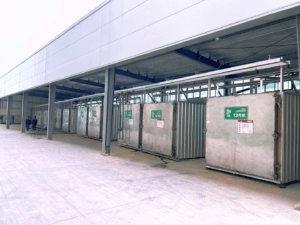
Introduction: Why Tropical Hardwoods Matter
If you’re into fine woodworking, tropical hardwoods are a top choice. Their unique colors, beautiful grain patterns, and toughness make them perfect for luxury furniture, musical instruments, and decorative items.
Some popular exotic hardwoods are:
- Ebony: Deep black with a fine texture.
- Teak: Durable and water-resistant, often used in boats and outdoor furniture.
- Rosewood: Rich colors and aroma, a favorite for fine furniture and instruments.
- Purpleheart: Naturally vibrant purple, great for decorative projects.
Among these, rosewood especially needs careful drying to keep its natural beauty and strength intact.
Table of Contents
Why Proper Drying of Rosewood Is So Important
Rosewood’s dense, oily texture makes drying tricky. If dried too fast or unevenly, it cracks, splits, or warps — ruining its value and usability. Proper drying keeps the wood strong, beautiful, and ready for crafting. Whether you’re a pro or hobbyist, mastering drying is key for great results.
Kiln Drying vs. Air Drying: What Works Best for Rosewood?
Air Drying
This traditional method involves stacking wood outdoors or in ventilated spaces for months or even years. It’s cheap but slow and weather-dependent, risking uneven drying, mold, or pests.
Kiln Drying
A controlled drying process inside a chamber where temperature, humidity, and airflow are carefully regulated. It offers:
- Faster drying (days or weeks, not months)
- Even moisture removal
- Fewer defects like cracks or warps
- Effective pest and mold control
For premium rosewood, kiln drying is the most reliable and scientific choice.
Step-by-Step Guide to Tropical Hardwood Drying
1. Select and Prepare Your Wood
- Choose boards of consistent thickness without big knots or splits.
- Cut or mill wood to size before drying.
- Seal ends with wax or commercial sealers to prevent cracking.
2. Stack Properly for Airflow
- Use thin, evenly spaced stickers (small wood strips) between boards.
- Align stickers vertically to avoid warping.
3. Pre-condition the Wood
- Slowly raise temperature just above room temperature to balance moisture inside before main drying starts.
4. Control Kiln Drying Parameters
- Start at about 30°C (86°F) for rosewood and increase gradually.
- Keep humidity high early on to prevent surface hardening, then reduce gradually.
- Maintain steady airflow for even drying.
5. Monitor Moisture Content
- Use moisture meters regularly to check inside the wood.
- Adjust kiln settings based on readings and inspections.
6. Conditioning Stage
- When moisture reaches 6-8% (ideal for indoor use), raise humidity slightly to relieve internal stresses.
7. Post-Drying Storage
- Store dried wood in dry, stable places with good air circulation.
- Avoid sudden temperature or humidity changes that cause cracking or moisture reabsorption.

Important Tips and Precautions While Drying
✅ Avoid Large Airflow Gaps in the Kiln: If the kiln isn’t fully loaded, big air channels form. This makes the upper wood dry too fast, bottom too slow. Increase stack height, adjust baffles and guides, and spray water on the floor if needed to keep humidity steady.
✅ Handling Long or Extra Thick Wood Pieces: Ensure stickers are consistent and placed within 10 cm from the ends. Add weights on top to prevent warping. For long wood, manually increase moisture at ends to prevent cracking. Use thicker stickers for thick wood so airflow is even.
✅ How Cutting Order Affects Drying Quality: For semi-finished pieces cut before drying, put the pith (center) near the surface to reduce cracks. Long pieces with sapwood or spiral grain in the middle are prone to warping, so plan cuts carefully.
✅ Dry Slowly: Fast drying causes cracks, warping, and internal damage.
✅ Seal the Ends: Ends dry fastest; sealing prevents end cracks.
✅ Monitor Often: Frequent moisture checks allow timely adjustments.
✅ Balance Quality & Speed: Don’t rush. Find a schedule that balances cost and quality.
✅ Understand Rosewood: Its oily, dense nature needs gentle drying.

Post-Drying Care: Cooling, Straightening & Conditioning
Cooling After Kiln Drying
After drying finishes, cool wood slowly to avoid cracking. Keep the kiln closed 24 hours, then open the small test door, followed by partial main door opening after 12 hours. Only remove wood once temperature drops below 35°C (95°F).
Straightening & Repairing Wood
Fix slightly warped or cracked boards using gas torches, clamps, or heat lamps to restore flatness before further processing.
Conditioning and Moisture Balancing
Store dried wood in a dry, ventilated place for slow moisture reabsorption (“conditioning”). This balances internal moisture and relieves stresses.
- Thin boards (<20mm): Condition at least 2 weeks.
- Thick boards: Condition 4 weeks or more.
Common Conditioning Methods
- Outdoor or open shed storage (protected from rain and pests).
- Indoor ventilated warehouses with airflow.
- Heated sealed conditioning kilns for controlled moisture balancing.
Conclusion
Drying rosewood properly is key to preserving its beauty and strength. Kiln drying with careful control over temperature, humidity, and airflow is the best way to get high-quality, stable wood ready for crafting fine furniture and art. Follow these steps, pay attention to details, and you’ll avoid cracking, warping, and other common issues — ensuring your rosewood pieces look amazing and last a lifetime. Find more at Tech Drying.
Tropical Hardwood Kiln Drying FAQ
How long does tropical hardwoods drying usually take?
Kiln drying hardwoods generally takes 2-8 weeks, while air drying can take 6 months to several years depending on wood thickness.
Is kiln drying better than air drying?
Yes. Kiln drying is faster, more uniform, and reduces defects like cracking, warping, mold, and insect damage.
What moisture content is ideal for dried rosewood?
About 6-8% moisture content is ideal for indoor use.
How can I prevent cracks during drying?
Dry slowly, seal the ends to prevent rapid moisture loss, maintain stable humidity early on, and use conditioning cycles to relieve internal stress.
How should dried tropical hardwood be stored?
Store in a dry, ventilated area away from direct sunlight and moisture. Use spacers to allow airflow and avoid tight stacking.
Do all types of tropical hardwoods require the same drying method?
Different rosewood species vary in density and oil content, so drying times and parameters may need slight adjustments.
What is the difference between drying and conditioning?
Drying removes most moisture, while conditioning balances internal moisture and relieves residual stress after drying.
Are drying schedules the same for all tropical hardwoods?
No, each tropical hardwood has its own ideal drying schedule. For example:
- Mahogany: Starts around 40°C with moderate humidity that gradually decreases.
- Teak: Requires a lower initial temperature (35-38°C) and careful humidity control to prevent cracking.
- Rosewood: Needs gentle drying starting as low as 30°C, with a slow temperature increase due to high oil content.















